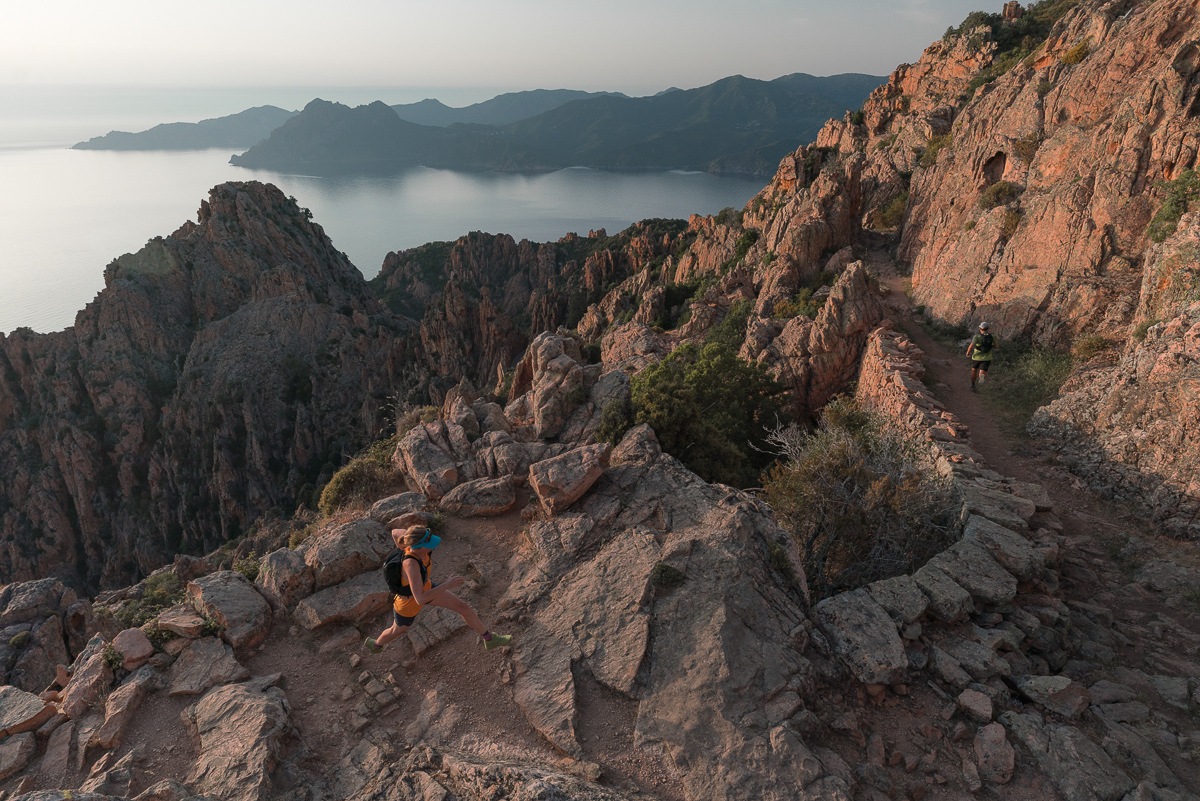Editor’s note: This article is part of the Joy of Resilience content series, sponsored by Arc’teryx. This article was first published on the Arc’teryx blog.
Words: Josh Barringer
Photos: Angela Percival
Each new adventure and new place I’m fortunate to visit, I always try to take away a word. One word, like a photo, can hold a depth of stories. As the plane approached Bastia I stared down at the vast coastline, wondering what the upcoming week on Corsica would reveal.
The first thing you notice arriving on Corsica is the beauty everywhere at once. The eye cannot decide where to put its focus. In one direction, clear, turquoise waters reach toward sandy bays and delicately placed old forts, while in the other direction, layers of looming granite spires fade into the distance. Each breath inflates your lungs with the unique aroma of the maquis, a scent so unmistakably wild and aromatic, it was the way marker for Napoleon Bonaparte returning to his homeland. Then comes the reminder you are indeed on an island and island time. Everything, everyone appears more relaxed and seemingly prideful in a slower pace of life than on “the continent,” as mainland France is affectionately referred.

Time here feels slower, well-aged. Over centuries of Italian and French rule, Corsica has developed a distinct culture and cuisine. The island is full of familiar dishes with an entirely Corsican variation. In the 1500s, a couple hundred years before the centuries of Italian ruling ended, landowners were required to plant four trees each year – olive, chestnut, fig, and mulberry. The chestnut became an integral component of the economy and the food. The wild boar eat them producing the distinct figatellu sausage. Chestnut flour began to be used in breads, pastries, pastas, and in moderna, Corsica’s most popular beer, Pietra.

It is with concerted effort and passing of traditions that the particular palette here developed. The flavours of these resilient and resourceful people is most apparent in the brocciu cheese, used in numerous recipes including fiadone, a cheesecake also utilizing chestnut flour. Brocciu resembles ricotta, but is made from ewe’s milk. However, unlike ricotta, it is not the curds, but the whey used to create brocciu. Shepherds not wanting to waste a drop of their valuable milk developed a method to make the whey, a recipe that was passed on for generations.
Corsica derives its name from Greek for of the Sirens. A more than fitting name for a place with an ancient tradition of polyphonic choruses, shimmering coastlines, and a vast and varied mountain wilderness. Roads connecting villages cling to the mountainsides. And through the middle of this remarkable island lay the GR20, a test of resilience for all who are drawn to its hypnotic song.
The GR20 is one of many Grande Randonnée footpaths in Europe, but is given the honour of being the most difficult. A claim seemingly unchallenged, which builds the mystique surrounding the terrain that lies within.

The north to south adventure of the GR20 begins with the smell of the sea and quickly ascends through pine forests and flowing pools of clear green water to shale-covered scrambles and the first views of Monte Cintu, the tallest peak on this mountain in the sea. The trail is unfiltered and raw. The ascents and descents are as aggressive as the flora. The terrain is so incredibly challenging it gives time – more accurately forces a stop – to admire sweeping views below and the coastline far in the distance. It beckons you to pause, let the mind rest before tackling another stretch. But qui n’avance pas, recule.

Beyond Monte Cintu are the glacial lakes of Vallée de la Restonica and moments of respite, flowing trails beside wild horse populated marshes, rolling through verdant land under a scorching sun. They are short lived though as towering scramble ascents postpone substantial progress. There are sections where a single misstep could be perilous. Each step must be carefully planned.

On the fringes of the mountains, villages hang with ease. Quiet streets are a sign the villageois have all gathered at the café for cards. Time to cure food and relationships. To experience the villages is to see the ancient time of Corsica, but to venture through the prehistoric mountains exposes its heart.
After traversing the spectacularly difficult Aiguilles de Bavella, the nearby glittering coastal city of Porto Vecchio offers regenerative soaks in the Mediterranean. A picturesque view to reflect on the toil of time on the GR20. There are many words I could use to describe this place. Distinct. Rugged. Delicious. But of Corse, it’s time.

